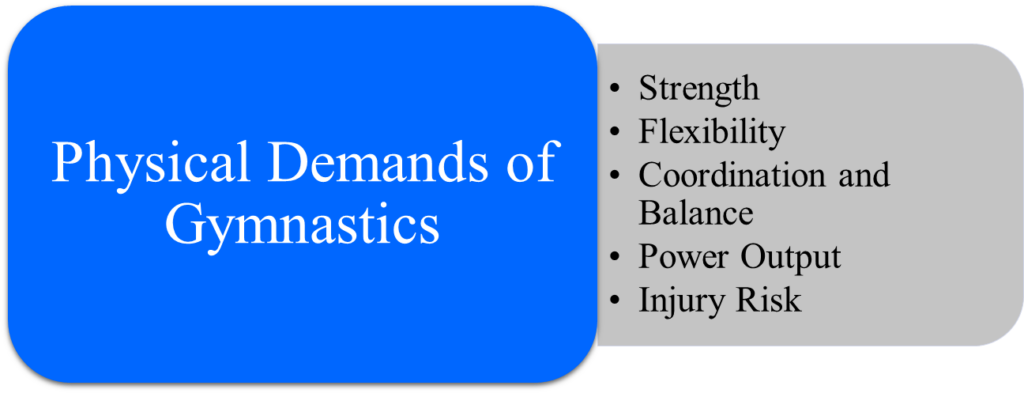Summary
Gymnastics is one of the most challenging sports due to its intense physical and mental demands. Gymnasts require exceptional strength, flexibility, balance, and precise coordination. Also, gymnasts face high risks of injury, intense training hours, and need resilience to overcome fear and adversity. The sport’s complexity includes hundreds of technical skills, each with strict performance standards, pushing gymnasts to develop a high level of focus and intellect. Unlike team sports, gymnastics is entirely individual, prioritizing relative strength and anaerobic endurance over aerobic stamina.
Declaring one sport the “hardest” over all others is a futile task. Every sport challenges the physical and mental aspects of an athlete differently. However, Gymnastics is a uniquely challenging sport that definitely belongs in the class of most difficult sports. Gymnasts develop particular attributes of athleticism that not many other sports can develop. Mentally, gymnasts need to be resilient, focused, and intelligent to be successful. Likewise, the level of commitment and complexity of gymnastics differentiates it from similar sports. Let’s breakdown in detail what makes gymnastics one of the hardest sports:
Physical Demands of Gymnastics

Strength
Gymnastics requires a large amount of strength to both produce and withstand the forces involved in the sport. Take a look at some of the forces going through the body during gymnastics:
- Upper Extremity Forces: 3.9x body weight for high bar, 9.2x body weight for rings, and 2.0x body weight for pommel horse
- Lower Body Forces: The forces that a gymnast’s body takes during landings can range between 5-18x bodyweight, with the highest recorded forces being at 23x bodyweight at the ankle (28-29).
Much of this required strength is relative to body weight, so this encourages a unique balance between strength and size. Gymnastics encourages a high strength-to-bodyweight ratio, focusing more on relative strength rather than absolute strength.
Flexibility
Gymnastics requires a large amount of mobility that many other sports don’t require. Primarily, flexibility is required for certain skills and to make other skills appear more aesthetic. Skills like split leaps on beam and floor require 180-degree splits in the air. In men’s gymnastics, skills like flairs on pommel horse require 120-degrees of leg separation.
However, flexibility also helps gymnasts move better and produce power more safely. Good ankle and hip mobility can help prevent leg injuries on landings, while shoulder mobility can prevent common shoulder injuries in gymnastics.
Coordination and balance:
Skills in gymnastics are full body movements that require both gross and fine motor control. Take for example tap swings on bars that involve hanging from the bars using the arms, changing shapes of the body through the torso and shoulders, while keeping legs together and straight with toes pointed. Releasing and regrasping the bar with the hands involves fine motor control of the hands as well.
Likewise, gymnastics involves balancing in unstable positions. Besides being in the name of “balance” beam, skills like handstands and strength elements on rings involve maintaining balance in an unstable static position.
Power Output:
Using strength, flexibility, and balance gymnasts produce immense power outputs in order to perform complex skills. A double back on floor requires generating power through quick shape changes in a round off and back handspring following with an explosive rebound into the air. This alone requires large power output, let alone when gymnasts add more flips and twists.
Risk of Injury
- In a 2007 study tracking injuries in college athletics, out of the 15 NCAA sports studied, Women’s Gymnastics had the second highest practice injury rate only to Men’s football. 6.1 per 1000 exposures to 9.6 per 1000 exposures.
- In a study published in 2015, Women’s gymnastics had the highest injury rate of all NCAA women’s sports.
- Shoulder Injuries are widespread in Men’s Gymnastics, where labrum and rotator cuff tears are common.
Mental Aspects of Gymnastics

Focus
- During Performance: Gymnastics requires an athlete to pay attention to small details of the body during performance of skills and drills. This level of internal awareness is important in every skill, and the attention to detail through multiple parts of the body is important for each skill.
- During Practice: Likewise, gymnasts have to focus on details of practice structures. In a particular event, they might have to an event specific warm up, routine assignments, skill drills, and skill practice to perform over the course of an hour. With multiple events plus warm up, strength and conditioning, for a gymnast to understand where to be and what to do in that span requires a high level of focus.
- Long Term: Gymnasts also need to stay focused on the long term details of training, such as the goals they set. With performance goals such as qualifying to national championships or to learn a certain skill by a certain date, gymnasts have to track the progress of there training over time.
Fear and Risk Taking
Due to the acrobatic nature of the sport, fear and risk are common to the sport. Accidents happen in gymnastics and gymnasts deal with mental blocks. To improve at the sport, gymnasts need a high level of resiliency and risk acceptance.
Knowledge and Intellect
Successful gymnasts have to absorb a lot of knowledge to be successful. The FIG Code of Points is a complex document, and gymnasts need to know a large number of rules to know how to put together the best performance. Likewise, gymnasts need to understand the principles behind a large number of skills on different events.
Clutch Performance
Gymnasts get one shot in a competition to perform. One mistake can be extremely costly, as differences in top scores in competition are sometimes less than a tenth. Routines are not short either, so gymnasts need to maintain composure for sometimes greater than a minute. This level of performance requires tremendous poise.
Level of Commitment
Gymnastics requires a large time commitment to reach the highest levels. Many gymnasts spend 20+ hours a week training gymnastics, and this often means sacrificing social life and dropping involvement in other sports and activities. However, the culture around the sport is slowly changing and later specialization and accomodating multi-sport athletes is becoming more encouraged.
Complex Nature of Gymnastics
Gymnasts perform a large variety of highly complex skills in connection from one to another. There are 4 events in women’s gymnastics and 6 events in men’s gymnastics, while the code of points lists over 100 possible skills for some events. In addition, each skill has a performance requirement that sets the standard of how the skill must be performed. Now often these skills share movement patterns or build on one another, but the sheer number of skills and variations far exceeds many sports.
To demonstrate how radical gymnastics can be, take a look at the hardest vault ever performed and the current list of most difficult vault’s in Men’s Gymnastics.
What Parts of Other Sports Are Missing In Gymnastics?
Sports like soccer, basketball, and football involve other teammates and opponents in the game action to determine results. In contrast, a gymnast’s score is awarded solely based off of their individual performance and is not affected directly by what competitors do.
Although gymnasts exhibit great relative strength, most gymnasts do not exhibit high levels of absolute strength. Consider how much more weight a football player can squat or deadlift compared to most gymnasts.
Gymnastics does not particularly target aerobic endurance. Although energy systems blend together, the aerobic system engages with activity lasting over 2 mins. So, with routines lasting under 90s, gymnastics primarily challenges anaerobic systems.

